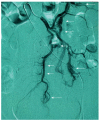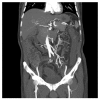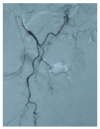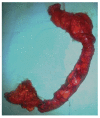Inferior mesenteric arteriovenous fistula: case report and world-literature review
- PMID: 25009407
- PMCID: PMC4081707
- DOI: 10.3748/wjg.v20.i25.8298
Inferior mesenteric arteriovenous fistula: case report and world-literature review
Abstract
Arteriovenous fistulas between the inferior mesenteric artery and vein are rare, with only 26 primary and secondary cases described in the literature. Secondary fistulas occur following operations of the left hemicolon and manifest as abdominal pain, abdominal mass, gastrointestinal bleeding, colonic ischemia and portal hypertension. Symptom intensities are flow-dependent, and can range from minimal symptoms to severe heart failure due to left to right shunt. Diagnosis is usually established by radiological or intraoperative examination. Treatment options include embolization and/or surgical resection. Therapeutic decisions should be adapted to the unique characteristics of the fistula on an individual basis. A new case of a primary arteriovenous fistula is described and discussed along with a complete review of the literature. The patient in this report presented with signs and symptoms of colonic ischemia without portal hypertension. The optimal treatment for this patient required a combination of embolization and surgical operation. The characteristics of these rare inferior mesenteric arteriovenous fistulas are examined and some considerations concerning diagnostic and therapeutic strategies that should be followed are presented.
Keywords: Arteriovenous fistula; Colectomy; Embolization; Inferior mesenteric artery; Portal hypertension.
Figures





References
-
- Vauthey JN, Tomczak RJ, Helmberger T, Gertsch P, Forsmark C, Caridi J, Reed A, Langham MR, Lauwers GY, Goffette P, et al. The arterioportal fistula syndrome: clinicopathologic features, diagnosis, and therapy. Gastroenterology. 1997;113:1390–1401. - PubMed
-
- Türkvatan A, Ozdemir Akdur P, Akdoğan M, Cumhur T, Olçer T, Parlak E. Inferior mesenteric arteriovenous fistula with ischemic colitis: multidetector computed tomographic angiography for diagnosis. Turk J Gastroenterol. 2009;20:67–70. - PubMed
-
- Blaisdell FW, Stein M. Natural history of congenital arteriovenous fistula. Cardiovasc Surg. 1998;6:566–568. - PubMed
-
- Fabre A, Abita T, Lachachi F, Rudelli P, Carlier M, Bocquel JB, Remond A, Pech de Laclause B, Maisonnette F, Durand-Fontanier S, et al. [Inferior mesenteric arteriovenous fistulas. Report of a case] Ann Chir. 2005;130:417–420. - PubMed
Publication types
MeSH terms
LinkOut - more resources
Full Text Sources
Other Literature Sources

